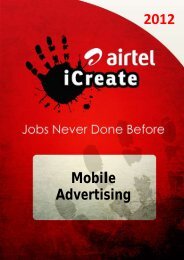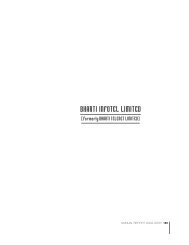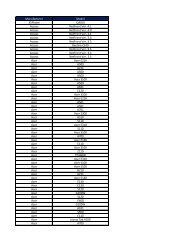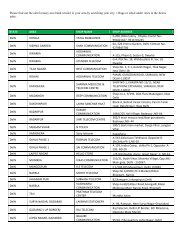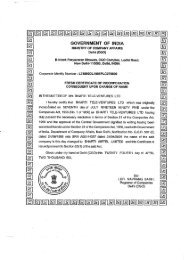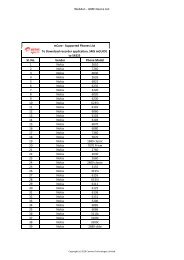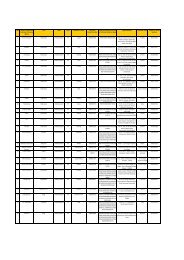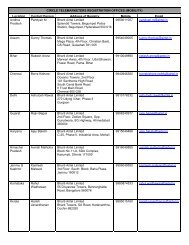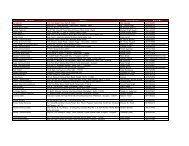Create successful ePaper yourself
Turn your PDF publications into a flip-book with our unique Google optimized e-Paper software.
Standard 15 (revised), “Employee Benefits’’. The<br />
Group makes annual contributions to the LIC for the<br />
Gratuity Plan in respect of employees at certain circles.<br />
(f) Other Long term employee benefits are provided<br />
based on actuarial valuation made at the end of each<br />
financial year. The actuarial valuation is done as per<br />
projected unit credit method.<br />
(g) Actuarial gains and losses are recognised as and when<br />
incurred.<br />
12.PRE-OPERATIVE EXPENDITURE<br />
Expenditure incurred by the Group from the date of<br />
acquisition of license for a new circle or from the date of<br />
start-up of new venture or business, up to the date of<br />
commencement of commercial operations of the circle or<br />
the new venture or business, not directly attributable to<br />
fixed assets are charged to the Profit and Loss Account in<br />
the year in which such expenditure is incurred.<br />
13.LEASES<br />
a) Where the Group is the lessee<br />
Leases where the lessor effectively retains<br />
substantially all the risks and benefits of ownership of<br />
the leased term, are classified as operating leases.<br />
Lease Rentals with respect to assets taken on<br />
‘Operating Lease’ are charged to the Profit and Loss<br />
Account on a straight-line basis over the lease term.<br />
Leases which effectively transfer to the Company<br />
substantially all the risks and benefits incidental to<br />
ownership of the leased item are classified as finance<br />
lease. Assets acquired on ‘Finance Lease’ which transfer<br />
risk and rewards of ownership to the Group are<br />
capitalised as assets by the Group at the lower of fair<br />
value of the leased property or the present value of the<br />
minimum lease payments or where applicable,<br />
estimated fair value of such assets.<br />
Amortization of capitalised leased assets is computed<br />
on the Straight Line method over the useful life of the<br />
assets. Lease rental payable is apportioned between<br />
principal and finance charge using the internal rate of<br />
return method. The finance charge is allocated over<br />
the lease term so as to produce a constant periodic<br />
rate of interest on the remaining balance of liability.<br />
b) Where the Group is the lessor<br />
Lease income in respect of ‘Operating Lease’ is<br />
recognised in the Profit and Loss Account on a straightline<br />
basis over the lease term.<br />
Finance leases as a dealer lessor are recognised as a<br />
sale transaction in the Profit and Loss Account and are<br />
treated as other outright sales.<br />
Finance Income is recognised based on a pattern<br />
reflecting a constant periodic rate of return on the<br />
net investment of the lessor outstanding in respect of<br />
the lease.<br />
c) Initial direct costs are expensed in the Profit and Loss<br />
Account at the inception of the lease.<br />
14.TAXATION<br />
Current Income tax is measured at the amount expected<br />
to be paid to the tax authorities in accordance with Indian<br />
Income Tax Act, 1961.<br />
Deferred income taxes reflects the impact of current year<br />
timing differences between taxable income and<br />
accounting income for the year and reversal of timing<br />
differences of earlier years. Deferred tax is measured at<br />
each balance sheet date based on the tax rates and the tax<br />
laws enacted or substantively enacted. Deferred tax assets<br />
and deferred tax liabilities across various countries of<br />
operation are not set-off against each other as the Group<br />
does not have a legal right to do so. Deferred tax assets are<br />
recognised only to the extent that there is reasonable<br />
certainity that sufficient future taxable income will be<br />
available against which such deferred tax assets can be<br />
realised. In situations where the Group has unabsorbed<br />
depreciation or carry forward tax losses, all deferred tax<br />
assets are recognised only if there is virtual certainty<br />
supported by convincing evidence that they can be<br />
realised against future taxable profits. Unrecognised<br />
deferred tax assets of earlier years are re-assessed and<br />
recognised to the extent that it has become reasonably<br />
certain that future taxable income will be available<br />
against which such deferred tax assets can be realized.<br />
Minimum Alternative tax (MAT) credit is recognised as an<br />
asset only when and to the extent there is convincing<br />
evidence that the Group will pay normal income tax<br />
during the specified period. In the period / year in which<br />
the MAT credit becomes eligible to be recognised as an<br />
asset in accordance with the recommendations contained<br />
in guidance Note issued by the Institute of Chartered<br />
Accountants of India, the said asset is created by way of a<br />
credit to the Profit and Loss Account and shown as MAT<br />
Credit Entitlement. The Group reviews the same at each<br />
balance sheet date and writes down the carrying amount<br />
of MAT Credit Entitlement to the extent there is no longer<br />
convincing evidence to the effect that Group will pay<br />
normal Income Tax during the specified period.<br />
Finance Act 2009, abolished ‘Fringe Benefit Tax’ effective<br />
April 1, 2009. Accordingly, the group has not accounted<br />
for fringe benefit tax.<br />
15.MISCELLANEOUS EXPENDITURE<br />
Premium on redemption of debentures is recognised as an<br />
expense in the Profit and Loss Account over the period of<br />
the related contract.<br />
16.BORROWING COST<br />
Bharti <strong>Airtel</strong> Annual Report 2009-10<br />
Borrowing cost attributable to the acquisition or<br />
construction of a qualifying asset is capitalised as part of<br />
the cost of that asset. Other borrowing costs are<br />
133



